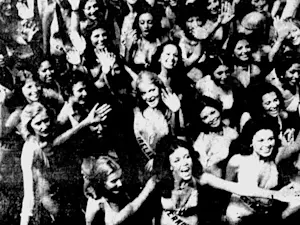
How Al Capone Ruled With Blood
Al Capone is one of the most infamous figures in American history, embodying the gangster archetype of the Prohibition era. Known as "Scarface," he ruled Chicago's underworld with a combination of ruthless violence, strategic alliances, and ostentatious charisma. But beneath his flashy public persona lay a darker reality — a legacy built on bootlegging, gambling, and bloodshed. From his early days in Brooklyn to his eventual downfall, Capone's story is a complex blend of ambition, crime, and human tragedy.
A Modest Start in Brooklyn
Alphonse Gabriel Capone was born on Jan. 17, 1899, in Brooklyn, New York. The fourth of nine children, Capone's parents were Italian immigrants seeking the promise of a better life in America. His father, a barber, and his mother, a seamstress, worked tirelessly to provide for their family in a cramped tenement. Capone's early life was unremarkable; by all accounts, he grew up in a stable, loving household.
Capone excelled in school during his early years, but his education was cut short when he struck back at a teacher who hit him. Expelled at 14, he began drifting toward Brooklyn's rougher streets. By this time, the family had moved to a better neighborhood in Park Slope, but the pull of street gangs proved irresistible. Capone joined the South Brooklyn Rippers and later the Five Points Juniors, petty gangs known for vandalism and minor crimes. These early affiliations marked the beginning of his journey into organized crime.
The Influence of Johnny Torrio
A turning point came when Capone met Johnny Torrio, a "gentleman gangster" who operated gambling and numbers rackets near Capone's home. Torrio, known for his preference for strategy over brute force, became a mentor to the young Capone, teaching him the business side of crime. Torrio's influence introduced Capone to the concept of organized crime as a sophisticated operation rather than mere street-level thuggery.
Torrio moved to Chicago in 1909 but maintained his relationship with Capone. By 1920, when Capone's father died, Torrio extended an invitation for Capone to join him in Chicago. Capone, eager for a fresh start and new opportunities, accepted.
Chicago: A Criminal Empire Takes Shape
Chicago in the 1920s was fertile ground for organized crime. Prohibition had just begun, and the demand for illegal alcohol was insatiable. Torrio, already established in the city's vice operations, saw an opportunity to dominate the burgeoning bootlegging market. Capone started as a low-level enforcer, but his mix of street smarts and bookkeeping expertise quickly earned him a promotion.
Capone's rise was swift but not without violence. In 1924, Capone and Torrio orchestrated the murder of rival gang leader Dion O'Banion, a move that escalated the city's gang wars. Torrio himself was nearly killed in a retaliatory attack in 1925, prompting him to retire and hand over control of his empire to the 26-year-old Capone.
The Public Face of Organized Crime
As the leader of Chicago's most powerful crime syndicate, Capone controlled an empire of brothels, gambling dens, speakeasies, and distilleries. By 1927, his operations were reportedly generating $100 million annually. Capone's wealth and influence extended beyond the criminal underworld; he had politicians, law enforcement, and judges on his payroll, ensuring a level of immunity from prosecution.
Capone's public persona further distinguished him from other gangsters. Unlike his mentor Torrio, who preferred to stay in the shadows, Capone cultivated a celebrity image. He was often photographed in flashy suits and his trademark white fedora, attending public events and mingling with Chicago's elite. To many, he was a paradox — a ruthless crime boss who also donated to charities, opened soup kitchens during the Great Depression, and tipped waiters generously.
Bloodshed and Infamy: The St. Valentine's Day Massacre
Capone's reign was defined by violence, none more infamous than the St. Valentine's Day Massacre on Feb. 14, 1929. The massacre was the culmination of a bitter rivalry with George "Bugs" Moran, leader of the North Side Gang. Capone's hitmen, disguised as police officers, lured seven members of Moran's gang into a garage and gunned them down in cold blood.
The sheer brutality of the massacre shocked the nation and marked a turning point in Capone's career. Though he was in Florida at the time and never charged with the crime, the public began to see him less as a charismatic rogue and more as a symbol of unchecked violence. The massacre also drew the attention of federal authorities, who redoubled their efforts to bring him to justice.
The Fall of Scarface: Tax Evasion and Alcatraz
Despite his numerous crimes, Capone was notoriously difficult to prosecute. Witnesses were often too intimidated to testify, and local law enforcement was deeply compromised. It wasn't until federal agents turned their attention to his finances that Capone's empire began to crumble.
In 1931, Capone was indicted on 22 counts of tax evasion. The trial was a high-profile affair, with Capone initially confident of a light sentence thanks to jury tampering and bribery. However, the judge switched the jury at the last moment, ensuring a fair trial. Capone was found guilty and sentenced to 11 years in prison, a $50,000 fine, and $30,000 in court costs. He served his sentence at several prisons, including the infamous Alcatraz, where he lost much of his influence.
Decline and Death
Imprisonment took a heavy toll on Capone. Years of untreated syphilis had advanced to neurosyphilis, causing significant cognitive decline. By the time of his release in 1939, Capone was a shadow of his former self. He spent his final years in Miami, living in relative obscurity with his wife, Mae, and their son, Sonny.
Capone died on Jan. 25, 1947, at the age of 48, from cardiac arrest following a stroke. The New York Times obituary described his death as "the end of an evil dream," underscoring the duality of his legacy — a figure both feared and oddly admired.
Legacy: The Myth and Reality of Al Capone
Al Capone's life is a study of contradictions. He was a ruthless criminal whose actions caused untold suffering, yet his public image remains strangely charismatic. His story has been immortalized in books, movies, and pop culture, often romanticizing his role as a larger-than-life antihero.
However, Capone's true legacy lies in the lessons his era teaches about unchecked power, corruption, and the societal costs of prohibition. His rise and fall exposed the vulnerabilities of American institutions, ultimately leading to reforms and the repeal of Prohibition. As much as his name is synonymous with organized crime, it is also a reminder of the dark undercurrents of ambition and excess.
Al Capone's journey from a Brooklyn tenement to the top of Chicago's underworld is as fascinating as it is cautionary. His life serves as a window into a turbulent time in American history, marked by moral contradictions and the relentless pursuit of wealth and power. While his myth may endure, the realities of his actions paint a far darker picture.
References: Al Capone - History.com | Biography of Al Capone - ThoughtCo























